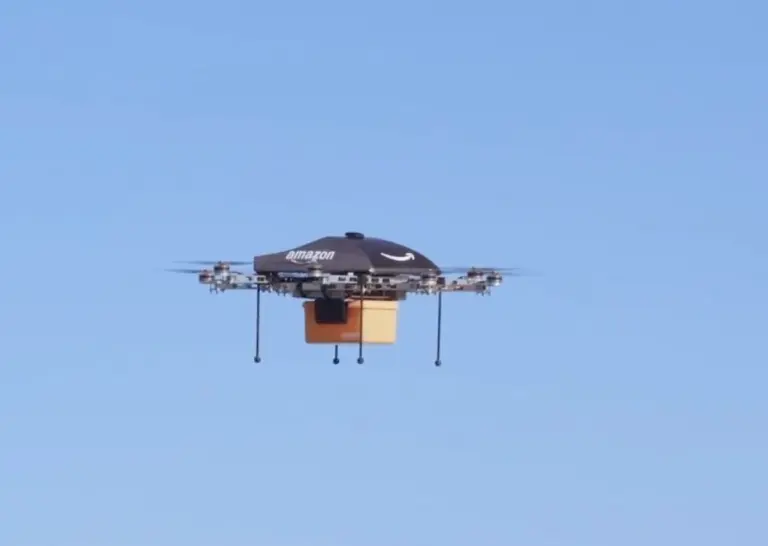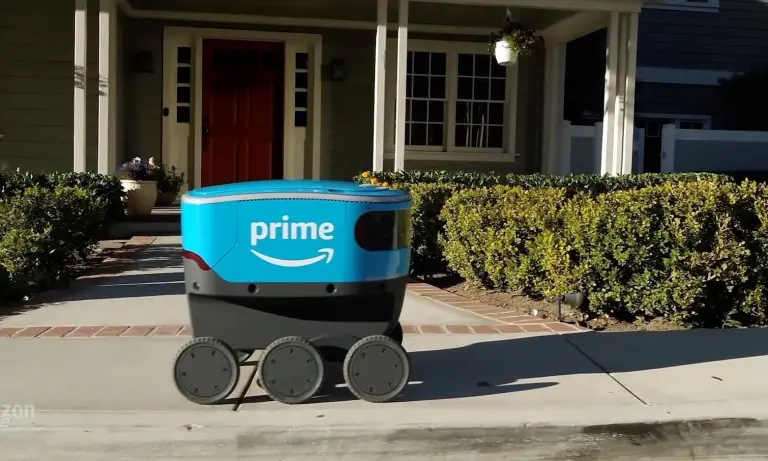Warehouse Robotic Automation
The rise of the COVID-19 pandemic revealed the weaknesses of systems and processes that relied only on physical presence, leading to a surge in automation.
- [BONUS] Download the nice PDF version of the lesson HERE!
These are warehouse robots:

The rise of the COVID-19 pandemic revealed the weaknesses of systems and processes that relied only on physical presence, leading to a surge in automation.

Robots and automated systems replaced the processes that used to be done manually or through face-to-face interaction.


As an example, Amazon started experimenting with deliveries using drones about eight years ago, but COVID-19 pandemic acted as a catalyst for Amazon to get approval for its delivery drones and start using its autonomous delivery vehicles that are autonomous mobile robots to deliver goods to customers.


Among these advances, the way that the work is done in warehouses and logistics has also been changed drastically based on the changing needs and demands of customers.
In this post, we will talk about the dramatic changes that happened in the automation of modern warehouses, and we will also feature an interview with Prime Robotics, one of the leading companies for warehouse robotic automation solutions (the interview is in the video version of this post).

Before diving into all this, let’s learn a short history of warehouse robotics.
A Short History of Warehouse Robotics
Unimate was the name of the first industrial robot deployed by General Motors in their assembly line in the 1960s. This robot was utilized to transport the die castings from an assembly line and weld those on auto bodies which was a dangerous task to be done by a worker. The robot consisted of an arm mounted on a large box, and a drum memory was used to store the tasks.

For a long time, industrial robots, which were primarily programmable robotic arms, were put in a cage separated from human workers because they were not safe to be used in proximity of humans. They were mainly used to conduct dangerous tasks unsafe for human workers.

Fast forward several decades, with the rise of the Internet of Things (IoT), Machine Learning (ML), advanced sensors, and Artificial Intelligence (AI) and integration of these technologies with robotic technology, the robots in warehouses became capable of operating autonomously and more safely alongside humans and a new era of human-robot collaboration began.
Let’s now discuss different types of warehouse robots.
Different Types of Warehouse Robots
Warehouse automation refers to automating storage and retrieval, picking, sortation, packaging, and palletizing. Material handling, packaging, and palletizing can quickly be done using the innovative new collaborative robots or cobots for short relieving workers from repetitive jobs and heavy lifting.

For instance, a palletizing robot is a robot that automates the picking and stacking of the products on pallets, reducing the danger to the employees and labor costs to the employers. Innovative grippers, computer vision, and machine learning systems can enable cobots to handle different kinds of objects with different shapes and sizes, even in unstructured environments.

Another example is Alibaba’s warehouse, where robots are used to automate bringing inventory in and out of storage, known as Storage and Retrieval Systems. These autonomous systems are machines that can operate autonomously without the need for a human operator that can be used to transport the inventory in the warehouse. They usually follow a path based on the map that they have of the warehouse to do these tasks.

The autonomous robots in warehouses are divided into the categories of Automated Guided Vehicles (AGVs), Autonomous mobile robots (AMRs), drones, and robotic arms that we will discuss each of them shortly.
Automated Guided Vehicles (AGVs) for Warehouse Robotic Automation
AGVs are used to transport inventory within warehouses. AGVs can travel along a fixed and static path. These routes are pre-established and marked by wires, magnetic strips, tracks, embedded sensors in the floor, or other physical guides. Some AGVs feature cameras, LIDAR, or infrared for autonomous navigation, obstacle identification, and avoidance. Alibaba’s warehouse above features AGVs for autonomously transporting goods.
Autonomous Mobile Robots (AMRs) for Warehouse Robotic Automation
AMRs are examples of autonomous vehicles that use different onboard sensors, computers, and maps to understand their environments. They can be considered to be smarter AGVs. Most of these robots can create their own routes based on the task needed and are capable of re-routing and obstacle avoidance. Picking, sorting, and inventory counting are some of the tasks that autonomous mobile robots can efficiently perform.

RFID technology, along with robot localization, is used to automate inventory counting for the warehouse to acquire a complete view of the warehouse and its assets, a tedious job that was previously done every few months promoting errors and inventory theft.

Some AMRs can also climb aisles in warehouses to retrieve customer orders.

AMRs are considered to be cobots, and they work in collaboration with human workers. At the warehouse, these robots either travel through a pick area, stop for the worker to perform the pick, or travel with the worker from one pick location to the other.
Drones for Warehouse Robotic Automation
Drones showed great potential for the logistics industry when in 2013, Amazon unveiled its futuristic plan of drone delivery. Drones can be used in warehouses to automate and optimize processes flying through challenging to reach and dangerous places in the warehouse to scan items on the highest shelves. Drones use vision sensors with deep learning algorithms for warehouse navigation.
Beul et al., in their article titled “Fast Autonomous Flight in Warehouses for Inventory Applications,” proposed a solution to autonomous drone flight for inventory applications in indoor environments like warehouses where positioning like GNSS are usually not available.


They used an RFID reader along with two high-resolution cameras to detect the stored items on warehouse shelves. Localization and mapping are done through the SLAM pipeline based on a 3D LIDAR. The LIDAR is the basis for the obstacle avoidance system as well.
Their solution provides fast and fully autonomous navigation and control, including avoiding static and dynamic obstacles in indoor and outdoor environments. The system can localize itself with a 3D LIDAR and a fast SLAM pipeline. LIDAR data is used to build a map and localize the object in the map. Fast flight is achieved through a time-optimal closed-loop trajectory generation and control.
As a piece of additional information, SLAM is defined as the computational problem in robotics navigation and mapping where it constructs and updates the map of an unknown environment and simultaneously locates the robot’s position within it.
Their drone could accomplish the mission of complete inventory of one shelf row and inspection of a single storage unit in another row requested from the warehouse management system (WMS).

Robotic Arms for Warehouse Robotic Automation
These pick and place robots feature specially designed grippers, vision systems, and AI integration for automation of picking & packing, Receiving/storage, or palletizing products. Some robotic arms are equipped with different grippers, and the AI learns the suitability of each gripper for a specific object and automatically switches the gripper for proper picking and packing.
Researchers from the University of Pisa in Italy presented one picking solution for dual robotic arms.

Humans pick objects through different means. They either rotate the object about vertical and horizontal axes, slide the objects, or use two hands; one will free the object from the pallet and the other hand primarily as support.
These techniques are also adopted in the robot. Inspired by human picking, the researchers used two seven Degrees of Freedom (DOFs) robotic arms with the end-effector in the form of soft hands and a support end-effector in the form of a velvet tray for this purpose.

As we discussed, motion planning is inspired by human motions for picking. Force/torque sensors are used to reactively plan the motion by detecting contact forces between the robot and the environment and if the gripper reached the target position.
Another solution for picking with a robotic arm is through a suction end-effector. For instance, researchers at the University of Bonn used a UR 10 arm with six DOFs with a foldable suction gripper with two DOFs for this purpose. A dual-camera setup was used to estimate the depth.


Costanzo et al. proposed a warehouse robotic solution system that can handle a single item rather than a whole box.

Specific supermarket items are handled through motion planning and grasp control based on tactile sensing and visual servoing. A KUKA robot with a gripper and tactile fingers are used, and the control system consists of a visual servoing controller and a grasp controller.

Integrating advanced sensors such as visual, audial, and haptic sensors into warehouse robots gives them the ability and knowledge to perceive their environment through vision and touch, which is nicely shown in this research. The data from these sensors play a pivotal role for AI and machine learning algorithms to be integrated into robots for making correct decisions based on input from their environment.
Conclusion
Robots are used for automating processes in warehouses, and they have become more and more popular, especially after the rise of the COVID pandemic, to increase the capability of doing more work and safety of the employees while decreasing the labor costs for employers. Humans can make errors when tired but not robots, and this leads to more inventory accuracy. The integration of IoT, better sensors such as cameras, and AI into robotic technology led to safer and more intelligent warehouse robotics.
References:
- https://www.automate.org/a3-content/joseph-engelberger-unimate
- https://www.tmgimpianti.com/impianti/pallettizzatore-per-sacchi-a-strato/
- https://palletizur.com/
- https://fetchrobotics.com/tagsurveyor/
- https://www.alibaba.com/
- Beul, M., Droeschel, D., Nieuwenhuisen, M., Quenzel, J., Houben, S. and Behnke, S., 2018. Fast autonomous flight in warehouses for inventory applications. IEEE Robotics and Automation Letters, 3(4), pp.3121-3128.
- Garabini, M., Caporale, D., Tincani, V., Palleschi, A., Gabellieri, C., Gugliotta, M., Settimi, A., Catalano, M.G., Grioli, G. and Pallottino, L., 2020. Wrapp-up: A dual-arm robot for intralogistics. IEEE Robotics & Automation Magazine.
- Schwarz, M., Milan, A., Lenz, C., Munoz, A., Periyasamy, A.S., Schreiber, M., Schüller, S. and Behnke, S., 2017, May. Nimbro picking: Versatile part handling for warehouse automation. In 2017 IEEE International Conference on Robotics and Automation (ICRA) (pp. 3032-3039). IEEE.
- Costanzo, M., De Maria, G., Lettera, G. and Natale, C., 2021. Can Robots Refill a Supermarket Shelf?: Motion Planning and Grasp Control. IEEE Robotics & Automation Magazine.
- https://nimble.ai/
- https://www.bionichive.com/
- https://primerobotics.com/
